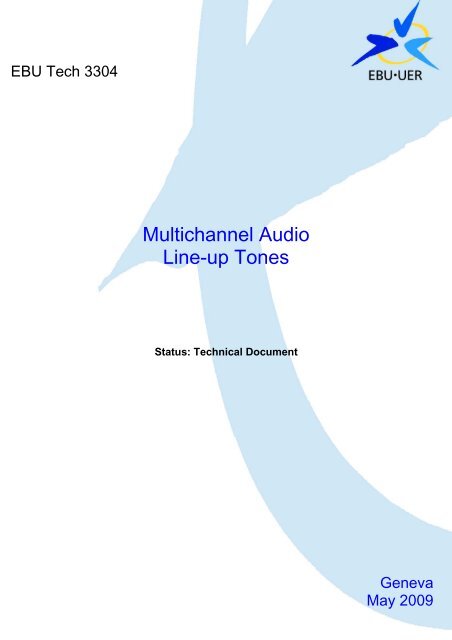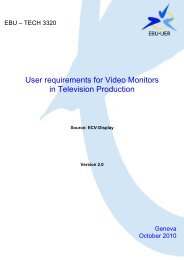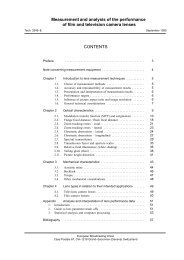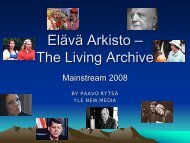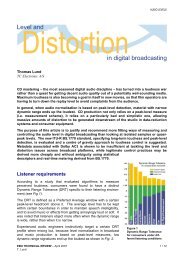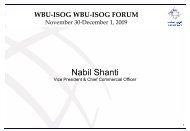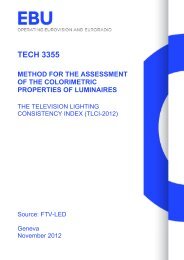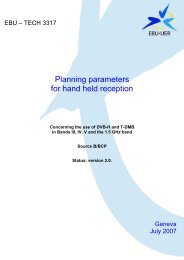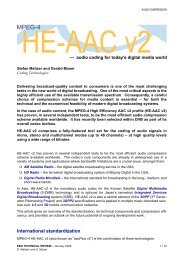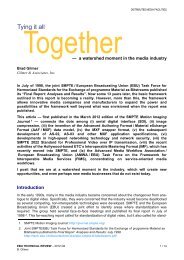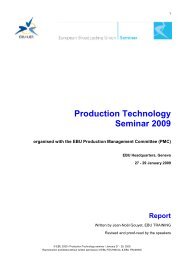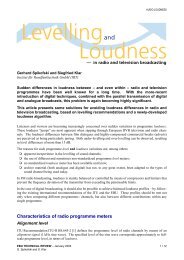Multichannel Audio Line-up Tones - EBU Technical
Multichannel Audio Line-up Tones - EBU Technical
Multichannel Audio Line-up Tones - EBU Technical
You also want an ePaper? Increase the reach of your titles
YUMPU automatically turns print PDFs into web optimized ePapers that Google loves.
<strong>EBU</strong> Tech 3304<br />
<strong>Multichannel</strong> <strong>Audio</strong><br />
<strong>Line</strong>-<strong>up</strong> <strong>Tones</strong><br />
Status: <strong>Technical</strong> Document<br />
Geneva<br />
May 2009
Tech 3304 <strong>Multichannel</strong> audio line-<strong>up</strong> tones<br />
Contents<br />
1. Introduction.................................................................................................. 5<br />
2. Existing line-<strong>up</strong> tone arrangements and uses ......................................................... 5<br />
2.1 Two channel audio identification....................................................................... 5<br />
2.2 Signal levels................................................................................................ 5<br />
3. Requirements for a multichannel line-<strong>up</strong> and identification signal............................... 6<br />
4. Temporal Identification of Spatial line-<strong>up</strong> signals .................................................... 6<br />
4.1 BLITS (Black and Lanes’ Ident <strong>Tones</strong> for Surround) .................................................. 6<br />
BLITS Frequencies ........................................................................................... 6<br />
BLITS Signal Timings......................................................................................... 7<br />
4.2 The <strong>EBU</strong> multichannel ident signal ..................................................................... 8<br />
Bibliography ....................................................................................................... 9<br />
3
<strong>Multichannel</strong> audio line-<strong>up</strong> tones Tech 3304<br />
4
Tech 3304 <strong>Multichannel</strong> audio line-<strong>up</strong> tones<br />
<strong>Multichannel</strong> <strong>Audio</strong> line-<strong>up</strong> <strong>Tones</strong><br />
<strong>EBU</strong> Committee First Issued Revised Re-issued<br />
PMC 2005 2009<br />
Keywords: <strong>Multichannel</strong> <strong>Audio</strong>, <strong>Line</strong>-<strong>up</strong> tone<br />
1. Introduction<br />
The primary uses of the alignment signal described are to identify the system and the channel<br />
allocations.<br />
In conjunction with an audio editing workstation, the described format can also provide a deeper<br />
insight into the history of received material.<br />
2. Existing line-<strong>up</strong> tone arrangements and uses<br />
2.1 Two channel audio identification<br />
<strong>EBU</strong> recommendation R 49-1999 [1] describes a line <strong>up</strong> tone that identifies the Left stereo, or<br />
channel 1, by means of interr<strong>up</strong>ting a 1 kHz tone at the alignment level for 250 ms every 3 seconds.<br />
This interr<strong>up</strong>tion enables phase relationships to be audibly checked, as well as checking and<br />
identifying the monophonic mix.<br />
1 s<br />
Figure 1: Stereo <strong>Line</strong>-<strong>up</strong> Tone<br />
This “<strong>EBU</strong> line-<strong>up</strong>” format is especially prevalent, and it will continue to be used for any two<br />
channel mix which may be carried along with multichannel “bundles” Thus any multichannel line<strong>up</strong><br />
arrangement must be easily differentiated from the two channel <strong>EBU</strong> version without any need<br />
for special equipment or training.<br />
Another existing alternative line-<strong>up</strong> format is often used for dual languages, heading the main<br />
language track with a continuous 1kHz tone, whist the secondary language on the track is headed<br />
by a 400 Hz signal. Experience has however shown that many operational staff find identification of<br />
isolated tone frequencies difficult.<br />
2.2 Signal levels<br />
Three different (but related) levels of line <strong>up</strong> signal are recognised internationally in<br />
ITU-R BS 645-2 [2]. They are known as "Alignment Level" (AL), " Permitted Maximum Level" (PML),<br />
and "Measurement Level" (ML).<br />
5<br />
Left<br />
Right
<strong>Multichannel</strong> audio line-<strong>up</strong> tones Tech 3304<br />
Alignment Level is the most enduring of these three signals, and it is the one to be found on the<br />
headers of recordings, or left connected on lines in the absence of programme.<br />
In R68-2000 [3] the <strong>EBU</strong> recommends that in digital audio equipment, its Members should use<br />
coding levels for digital audio signals which correspond to an alignment level which is 18 dB below<br />
the maximum possible coding level of the digital system, irrespective of the total number of bits<br />
available.<br />
Permitted Maximum Level on the other hand, equates to the peak modulation on a Radio link or<br />
emission. It is set at a level 8 or 9 dB higher than Alignment level, depending on the regulatory<br />
authority. Note that this nominal peak level for broadcast use is some 9 or 10 dB lower than the<br />
peak digital modulation on “finished” commercial recordings, such as CD or DVD, although transient<br />
excursions of peak signal <strong>up</strong> to 6 dB above PML may occur in practice.<br />
3. Requirements for a multichannel line-<strong>up</strong> and identification signal<br />
Typical broadcast multichannel audio may be in the form of interleaved or related mono MBWF<br />
files, in accordance with <strong>EBU</strong> R123-2009 [4], R111-2004 [5], or maybe stereo pairs or multitrack<br />
tape tracks to <strong>EBU</strong> R91-2004 [6] or to R48-2005 [7].<br />
Any <strong>Line</strong>-<strong>up</strong> procedure must therefore establish:-<br />
• The presence and spatial position of all the main channels.<br />
• The presence of an LFE channel if s<strong>up</strong>plied.<br />
• Consistent signal levels compatible with conventional programme level meters.<br />
• Quantitative indication of the matrix coefficients used for stereo or mono downmixes.<br />
4. Temporal Identification of Spatial line-<strong>up</strong> signals<br />
4.1 BLITS (Black and Lanes’ Ident <strong>Tones</strong> for Surround)<br />
The “BLITS” test sequence was developed by Martin Black and Keith Lane, both Senior Sound<br />
S<strong>up</strong>ervisors at BSkyB in the UK. The requirement was to develop a signal that enabled the<br />
identification of all the channels in a 5.1 mix, yet was still meaningful when monitoring the stereo<br />
downmix of the 5.1 signal. A discussion of the design of the BLITS signal is to be found in [8].<br />
The BLITS signal is now in common use amongst several European broadcasters and generators are<br />
commercially manufactured. The BLITS signal sequence is recommended for normal 5.1 channel<br />
programme headers.<br />
Figure 2 represents the BLITS sequence; note that this figure is not to scale.<br />
BLITS Frequencies<br />
The frequencies used are based on the international musical standard of A = 440 Hz and the<br />
interval of a perfect fifth above it (E).<br />
The actual frequencies used are:<br />
L = 880 Hz R = 880 Hz<br />
C = 1320 Hz LFE = 82.5 Hz<br />
Ls = 660 Hz Rs = 660 Hz<br />
6
Tech 3304 <strong>Multichannel</strong> audio line-<strong>up</strong> tones<br />
BLITS Signal Timings<br />
Figure 2: BLITS 5.1 Ident (not to scale)<br />
The sequence is composed of three distinct sections, as follows.<br />
Section 1: 5.1 Idents section, various frequencies @ -18dBfs:<br />
Each channel is identified by a tone burst of 600ms duration, with a spacing of 200ms between tone<br />
bursts, followed by 200ms of silence. This sequence runs from 0.00s > 4.80s (i.e. duration = 4.80s).<br />
Section 2: “Stereo” ident section, 1 kHz @ -18dBfs:<br />
The right channel is a continuous tone burst of 5.1s duration.<br />
The left channel is a discontinuous tone burst. The breaks in the left channel are at 1s, for 300ms,<br />
then on-and-off for 300ms, three more times, followed by 2s of steady tone.<br />
Then silence for 300ms on both left and right channels.<br />
This sequence runs from 4.80s > 10.20s (i.e. duration = 5.40s).<br />
Section 3: Phase-check section, 2 kHz @ -24dBfs:<br />
All channels contain 3s of in-phase 2kHz tone, followed by 200ms of silence.<br />
This sequence runs from 10.20s > 13.40s (i.e. duration = 3.20s).<br />
The total duration of a complete BLITS sequence is therefore 13.40s.<br />
The sequence may repeat indefinitely.<br />
7
<strong>Multichannel</strong> audio line-<strong>up</strong> tones Tech 3304<br />
4.2 The <strong>EBU</strong> multichannel ident signal<br />
The <strong>EBU</strong> multichannel 1 kHz line-<strong>up</strong> signal is recommended for systems other than 5.1, and where<br />
high downmix levels would be acceptable. The ident sequence is represented in Figure 3.<br />
1 s<br />
Channel Identification<br />
Figure 3: <strong>EBU</strong> multichannel line<strong>up</strong> tone sequence<br />
8<br />
Front Left<br />
Centre<br />
Front Right<br />
Right Surround<br />
Left Surround<br />
On all the main channels, 3 seconds of 1 kHz coherent tone are followed by 0.5 s silence, then all<br />
the main channels are identified in clockwise reproduction order, starting at front left.<br />
The identification consists of an individual 0.5 s burst of 1 kHz tone spaced by a 0.5 s silence gap<br />
before the next channel in line is identified. After a final 1 s of silence the sequence repeats with<br />
three seconds of tone on all main channels.<br />
1. The total period occ<strong>up</strong>ied in the identification therefore shows the total number of main<br />
channels to be expected, i.e. 6.0 s for 5.0 or 5.1 signals, 7.0 s for 6.1, and 8.0 s for 7.1 etc.<br />
2. Any signal formed from a combination of these channels will retain the bursts at the levels used<br />
in the matrix.<br />
3. The LFE channel carries 80 Hz continuous tone. Although the tone is recorded at line-<strong>up</strong> level,<br />
this channel is conventionally reproduced at a level 10 dB higher than the main channels (see<br />
Tech 3276 s1 [9] for channel alignment). However, the low perceived loudness of 80 Hz tone,<br />
ensures an even balance is maintained.<br />
The sequence then may repeat indefinitely.<br />
LFE
Tech 3304 <strong>Multichannel</strong> audio line-<strong>up</strong> tones<br />
Bibliography<br />
[1] R49-1999 Tape alignment leader for the exchange of television programmes<br />
[2] ITU-R BS645-2 Test signals and metering to be used on international sound-programme<br />
connections<br />
[3] R68-2000 Alignment level in digital audio production equipment and in digital<br />
audio recorders<br />
[4] R123-2009 <strong>EBU</strong> <strong>Audio</strong> Track Allocation for File Exchange<br />
[5] R111-2004 <strong>Multichannel</strong> use of the BWF audio file format (MBWF)<br />
[6] R91-2004 Track allocations and recording levels for the exchange of multichannel<br />
audio signals<br />
[7] R48-2005 Allocation of audio tracks on digital television recorders<br />
[8] IBS Journal BLITS Surround Sound Ident, Martin Black MIBS – Feb/Mar 2007 Issue of<br />
<strong>Line</strong> UP Magazine<br />
[9] Tech 3276 s<strong>up</strong>pl.1 Listening conditions for the assessment of sound programme material:<br />
multichannel sound<br />
9


